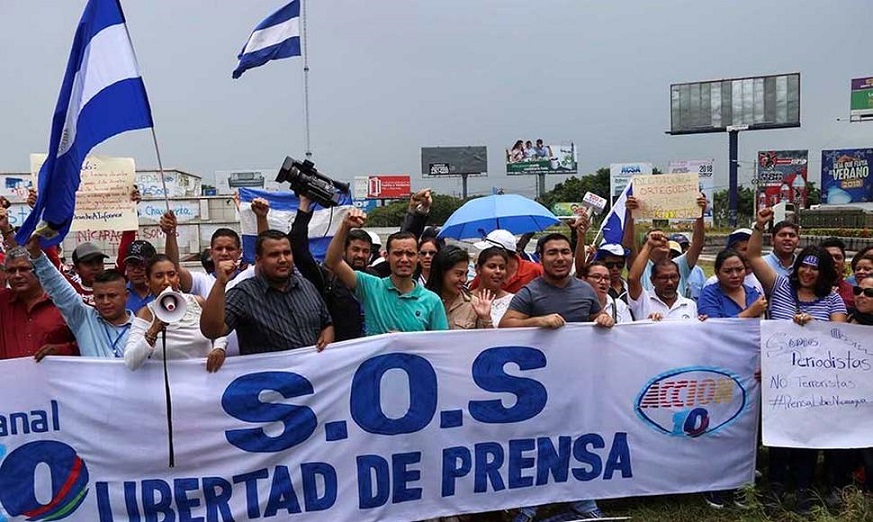Journalists have been beaten, arrested, and robbed in the wake of the civil revolt that paralyzed the country earlier in the year
Toby Stirling Hill
in Managua
MANAGUA, Nicaragua, Mon 10 Dec 2018 – Nicaraguan TV journalist Miguel Mora was driving home from work when he was pulled over by armed police.
“They ordered me take off my glasses and put a hood over my head,” says Mora, who directs the 100% Noticias news channel. “Then they took me by the neck and forced me into a pickup, where an officer told me: ‘You’re responsible for the death of police. If you keep fucking around, we’re going to kill you and your whole family.’”
It was the sixth time Mora had been detained by police in the space of a week. He also faces criminal charges of “inciting hate”, while drones have filmed his house and armed men on motorbikes track his movements.
Such intimidation is part of an escalating assault on press freedoms in Nicaragua, unleashed in the wake of the civil revolt that paralyzed the country earlier in the year.
Journalists have been beaten, arrested and robbed; radio stations raided by police. Last week, both the UN and the IACHR condemned the intensifying harassment.
“This government has banned protest, captured opposition leaders, and now the only thing preventing a totalitarian dictatorship is the independent media,” says Mora. “This is the stage where they try to silence us.”
Anti-government protests broke out in April, sparked by the mismanagement of fires in a protected reserve and fuelled by fiscal reforms that slashed social security. They spread after police used live ammunition on demonstrators, killing dozens.
As the crisis worsened, 100 % Noticias beamed police and paramilitary violence into homes across the country. Newspapers exposed the state’s lethal tactics: one investigation drew on radiographic evidence to show that many of the deaths were the result of a single gunshot to the head, neck or chest – proof that state forces were shooting to kill.
From the start of the unrest, the government tried to control coverage, pressuring media bosses to self-censor. Journalists at Channel 10 – owned by the Mexican tycoon Remigio Ángel González – were initially barred from reporting on demonstrations.
“It was absurd: historic events were unfolding and we were ignoring them,” says Mauricio Madrigal, the station’s news editor. He and others threatened to resign, and the prohibition was dropped.
After that approach failed, officials turned to more direct tactics. Twelve members of Madrigal’s team have since quit, fearing for their family’s safety. Two 100% Noticias journalists have fled the country; on Saturday, a cameraman was seized by gunmen in civilian clothes as he left the channel’s headquarters, and thrown in jail.
“Every independent journalist has received death threats,” says Gerall Chávez, a reporter with VosTV, whose house was vandalized in August. One journalist has been killed during the violence; in total, more than 490 violations of press freedom have been documented in the course of the crisis. Now, having regained control of the streets, the government is determined to impose control over the narrative. In doing so, it aims to ensure impunity for the state forces that slaughtered hundreds of protesters.
“It’s an Orwellian strategy, to falsify the reality of the repression,” says Sofía Montenegro, a journalist and former Sandinista guerrilla who fought alongside President Daniel Ortega in the 1970s.
The official version of events is disseminated through a media empire built by Rosario Murillo, Nicaragua’s first lady and, since 2017, vice-president.
In 2007, shortly after her husband returned to power, Murillo published an ominous communication strategy, outlining plans to prevent critical media “contaminating” public perception of his administration.
Through the next decade, Murillo spent millions of dollars of Venezuelan cooperation funds – ostensibly destined for poverty reduction – on buying up Nicaragua’s media.
TV channels 4, 8, 9 and 13 are now owned by her children; also under the family’s control are Radio Ya, Radio Nicaragua and Radio Sandino, state broadcaster Channel 6, and the online news service El 19 Digital.
From April, this media apparatus worked to whitewash the government’s deadly response to the protests.
“We presented an alternative reality, where protesters were rightwing extremists killing Sandinistas,” says Carlos Mikel Espinoza, who was editor of El 19 Digital when protests broke out. “It was fascistic, an attempt to infuse hatred into government supporters and police.” Espinoza quit and fled to Costa Rica in June, after police and militants burned alive a family of six in their own home.
Murillo’s strategy has failed. Polls show that just one in five Nicaraguans believe the official line that “those who participated in roadblocks and marches are terrorists”. But this hasn’t stopped the Ortega-controlled courts prosecuting protesters as if they were the violent extremists government propaganda claims.
“We challenge this fantasy reality every day,” Miguel Mora concludes. “The logical next step – which I fully expect them to take – is to send their paramilitaries to close us down altogether.
“That would leave only their version of events: a pure, uncontaminated discourse.” – (the Bay Guardian).



